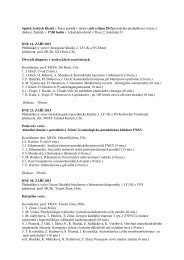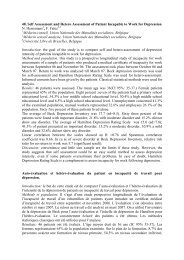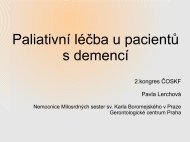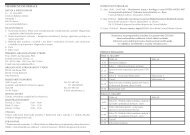ABSTRACTS â ORAL PRESENTATIONS - AMCA, spol. s r.o.
ABSTRACTS â ORAL PRESENTATIONS - AMCA, spol. s r.o.
ABSTRACTS â ORAL PRESENTATIONS - AMCA, spol. s r.o.
You also want an ePaper? Increase the reach of your titles
YUMPU automatically turns print PDFs into web optimized ePapers that Google loves.
P59. EARLY DIAGNOSTICS OF CARTILAGE-HAIR HYPOPLASIA AS A CAUSE OF SEVERE<br />
COMBINED IMMUNODEFICIENCY (SCID) USING FLOW CYTOMETRY AND TREC/KREC<br />
ANALYSIS<br />
Kotrová Michaela 1 , Formánková Renata 1 , Mejstříková Ester 1 , Froňková Eva 1 , Říha Petr 1 ,<br />
Svatoň Michael 1 , Baxová Alice 2 , Šedivá Anna 3 , Sedláček Petr 1 , Starý Jan 1<br />
1<br />
Department of Paediatric Haematology and Oncology, 2 nd Faculty of Medicine, Charles<br />
University in Prague and Motol University Hospital michaela.kotrova@lfmotol.cuni.cz<br />
2<br />
Institute of Biology and Department of Medical Genetics 1 st Faculty of Medicine,<br />
Charles University, Prague and General Teaching Hospital<br />
3<br />
Department of Immunology, 2 nd Faculty of Medicine, Charles University in Prague<br />
and Motol University Hospital<br />
Cartilage-hair hypoplasia (CHH), also known as metaphyseal chondrodysplasia, is a rare<br />
autosomal recessive genetic disorder caused by mutations of the RMRP gene, encoding<br />
non-protein RNA Component of Mitochondrial RNA Processing Endoribonuclease.<br />
Mutations in this area can lead to a wide spectrum of signs and symptoms including<br />
different degrees of short stature, hair hypoplasia, defective erythrogenesis, and<br />
immunodeficiency. The immunodeficiency in CHH can present as isolated T-cell or B-cell<br />
immunodeficiency, or combined T-cell and B-cell immunodeficiency. In CHH patients,<br />
allogeneic hematopoietic stem cell transplantation (HSCT) can correct immune deficiency<br />
and anemia but has no effect on skeletal changes.<br />
A 2.5 months girl presented with systemic cytomegalovirus (CMV) disease, CMV<br />
interstitial pneumonia and rotaviral enteritis. Flow cytometry evaluation of peripheral<br />
blood revealed 67% of granulocytes, 6.2% of lymfocytes and 23% of monocytes according<br />
to CD45+14++. CD19+ B lymphocytes prevailed, the T lymphocytes were in minority<br />
(4.6%) and only CD3+4+ and TCR gamma/delta cells were present. Within CD3+4+cells,<br />
98.2% of cells were CD45RO positive, suggesting maternofetal engraftment or oligoclonal<br />
expansion of residual T cells. B cell compartment consisted mostly of IgD+CD27neg naïve<br />
B cells (97%), IgMnegIgDnegCD27pos class switched memory B cells and plasmablasts<br />
were almost missing (0.18%). The diagnosis of SCID was subsequently confirmed by<br />
recombination circle quantitative PCR analysis aiming at detection of newly derived T<br />
(„TREC“) and B („KREC“) cells. TRECs were not present in the peripheral blood, while<br />
KREC levels did not differ from those in healthy newborns, indicating complete early<br />
block in alpha/beta T-cell development and normal development of B lymphocytes until<br />
the stage of class switching. The patient has successfully undergone HSCT at the age of<br />
three months with unrelated matched cord blood.<br />
The exome sequencing was performed with the aim to find underlying mutation after the<br />
exclusion of IL7R defect. However, neither any mutation in ~20 known genes associated<br />
with T-B+ SCID, nor any new, previously undescribed mutation was found. Skeletal<br />
dysplasia was detected in the patient by ultrasound already in the 36th gestational<br />
week and diagnosis of CHH was suggested by clinical genetician at the age of 5 months.<br />
As non-protein coding gene, RMRP was not covered sufficiently in exome sequencing<br />
library (Nimblegen SeqCap EZ Human Exome Library v2.0). We performed a molecular<br />
158 Analytical Cytometry VII








